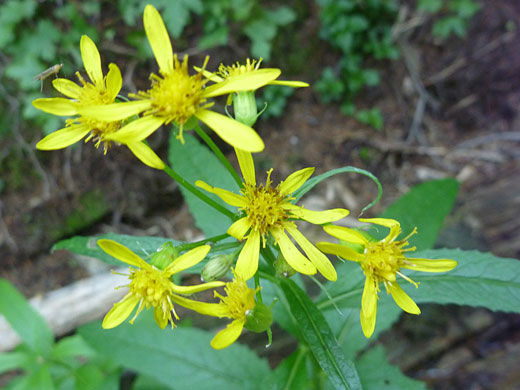
Police-car moth on a flower of senecio serra; along the Sneffels Highline Trail in the San Juan Mountains, Colorado
Common names:
Tall ragwort, butterweed groundsel
Family:
Scientific name:
Senecio serra
Main flower color:
Range:
The Rocky Mountains and states to the west, except Arizona
Height:
Usually up to 3 feet, sometimes 6 or more
Habitat:
Woodland, meadows, streamsides, sagebrush; 3,500 to 10,500 feet
Leaves:
Narrow, lanceolate, up to 7 inches long, with toothed edges and a prominent midvein
Season:
June to August
The leaves are the best way to identify senecio serra; they grow at the base and at even intervals along the stem, and are narrowly lanceolate in shape, lined by small, irregularly-spaced but generally well-separated teeth. The similar senecio-triangularis, which is found in the same regions, has leaves that are triangular, with larger, more regular edge teeth.
The plant forms spreading clusters of 30 to 100 flowerheads, each consisting of around 5 or 8 yellow ray florets and between 10 and 50 disc florets. The non-overlapping green phyllaries may have dark tips; there are usually either 8 of 13 of them. Leaves and stems are generally hairless. This is a tall senecio species, occasionally up to 8 feet in height.
Two varieties are var serra which has smaller heads (5 rays, 10 to 20 discs) in a larger cluster, and the less common var admirabilis, where the flowers are larger (8 rays, 20 to 50 discs) and the cluster contains fewer heads, around 40.
The plant forms spreading clusters of 30 to 100 flowerheads, each consisting of around 5 or 8 yellow ray florets and between 10 and 50 disc florets. The non-overlapping green phyllaries may have dark tips; there are usually either 8 of 13 of them. Leaves and stems are generally hairless. This is a tall senecio species, occasionally up to 8 feet in height.
Two varieties are var serra which has smaller heads (5 rays, 10 to 20 discs) in a larger cluster, and the less common var admirabilis, where the flowers are larger (8 rays, 20 to 50 discs) and the cluster contains fewer heads, around 40.
All Contents © Copyright The American Southwest | Comments and Questions | Contribute | Site Map



